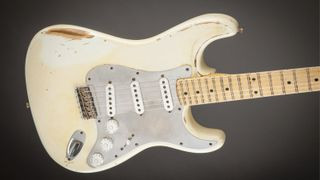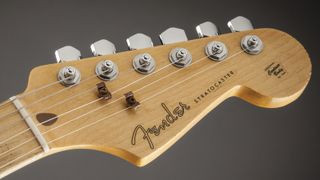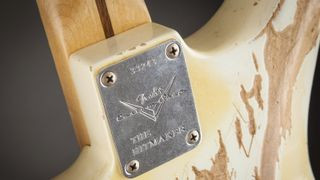Nile Rodgers. The name conjures up images of shimmering disco grooves, infectious funk rhythms, and an unparalleled catalog of hits that have defined generations of music. Central to his signature sound and legendary career is a single instrument: his heavily modified 1960 Fender Stratocaster, affectionately known as “The Hitmaker.” This isn’t just any guitar; it’s the sonic paintbrush behind countless chart-toppers for Chic, David Bowie, Madonna, and many more. For decades, the Nile Rodgers Guitar has remained an enigma, a source of fascination for musicians and fans alike. Now, Fender has unveiled a limited-edition replica, the Nile Rodgers Hitmaker Stratocaster, inviting players to delve into the magic of this legendary instrument. But what exactly makes this nile rodgers guitar so special? Let’s explore the fascinating story behind the Hitmaker and its enduring influence on music.
The Hitmaker Stratocaster isn’t your average off-the-shelf Fender. Its most immediately striking feature is its smaller body, a characteristic that Nile Rodgers himself describes as “mystifying.” Even Fender experts haven’t definitively solved the mystery of its diminutive dimensions. “There are all these different stories I get from people at Fender,” Rodgers recounts, “but you know, they weren’t there when that happened.” Theories abound, including the intriguing suggestion from Richie Sambora that it might be a modified Mary Kaye Stratocaster, a highly sought-after 1950s model. Whether a manufacturing anomaly or a deliberate alteration, this smaller body contributes to the guitar’s unique feel and possibly its resonant qualities.
 Nile Rodgers Hitmaker Stratocaster close up
Nile Rodgers Hitmaker Stratocaster close up
Adding to the guitar’s mystique is its 1959 neck. Rodgers learned from Fender that necks from that year were unsigned due to a disciplinary action against a factory worker. This detail, initially unknown to Rodgers, adds another layer to the Hitmaker’s already rich history. Beyond its unusual body and neck, the nile rodgers guitar is visually defined by its striking modifications. The mirror pickguard, a purely aesthetic choice, reflects stage lights and adds a touch of showmanship to Rodgers’ performances. He also replaced the standard Stratocaster knobs with Gibson “speed” knobs, a practical modification that allows for quick volume swells, a technique essential to many R&B and funk styles. These modifications, combined with its Olympic White finish (originally refinished by Rodgers himself), contribute to the Hitmaker’s distinct and recognizable appearance.
Before the Stratocaster became his signature, Nile Rodgers’ guitar journey began with jazz and archtop instruments. He initially favored a Gibson Barney Kessel, a classic jazz guitar, reflecting his early musical influences. “I had only played jazz guitars up until then,” Rodgers explains. His mother even bought him a Fender Mustang early on, but the solid-body feel didn’t resonate with him at the time, leading him back to hollow-body instruments. His preference for larger guitars stemmed from his classical guitar training, where he was “accustomed to a big, fat body.” However, a pivotal moment arrived when his band, New York City, opened for the Jackson 5.
 Nile Rodgers performing with Hitmaker Stratocaster
Nile Rodgers performing with Hitmaker Stratocaster
Witnessing the sound of a Stratocaster in action, played by the opening act of his own band, sparked a revelation. “When this kid plugged into my amp and sounded, like, 10 times better than I did playing the same kind of songs… I was going, ‘Damn, that’s how the song should sound!'” This experience, coupled with encouragement from his Chic partner Bernard Edwards, propelled Rodgers to make the switch. In a decisive move, Rodgers traded his Barney Kessel for “the cheapest Strat in the store” at a pawnshop. This marked the beginning of his enduring relationship with the Stratocaster and the genesis of the Hitmaker.
Upon acquiring his Stratocaster, Nile Rodgers, with his background as a guitar repairman, immediately began customizing it to his preferences. Dissatisfied with the original color, he refinished it in a “yellowish antique white” to emulate the look of Jimi Hendrix’s guitar, a significant influence on his playing. The addition of the mirror pickguard was a purely stylistic choice, designed to enhance his stage presence. The Gibson speed knobs were a more functional modification, enabling him to execute volume swells with his pinky finger, a crucial technique for emulating the dynamic sounds of R&B hits like Marvin Gaye’s “Let’s Get it On.” Furthermore, Rodgers upgraded the machine heads to ensure tuning stability, a testament to his commitment to performance reliability. This dedication to staying in tune is legendary; Rodgers famously plays entire concerts with just the Hitmaker, preferring to stop the show rather than switch guitars if a string breaks, a rare occurrence for him.
Nile Rodgers’ signature guitar tone is as distinctive as the Hitmaker itself. A key element is his consistent use of the neck pickup. “I’m always on the front pickup,” he states, although he acknowledges using other pickup positions in the studio for layering guitar parts. This preference for the neck pickup contributes to the warm, rounded tone that contrasts with the often brighter sounds associated with funk guitar. His choice of light gauge strings and a light pick further shapes his sound, allowing for projection while maintaining body and resonance, particularly on the lower strings. “With me it’s all about the first three strings and the middle three,” Rodgers explains, highlighting his focus on melodic clarity and rhythmic precision.
 Nile Rodgers Hitmaker Stratocaster body detail
Nile Rodgers Hitmaker Stratocaster body detail
Another crucial aspect of Rodgers’ tone is his pioneering use of a direct signal blended with an amplified signal. This technique, refined through his collaborations with engineer Bob Clearmountain, creates a unique sonic texture that combines the warmth of an amplifier with the clarity and immediacy of a direct input. This blend has become integral to his sound, influencing his playing technique and contributing to the instantly recognizable Nile Rodgers guitar sound that permeates his vast discography.
Beyond his work with Chic, the nile rodgers guitar has been instrumental in his prolific production career. From David Bowie’s “Let’s Dance” to Madonna’s “Like a Virgin” and INXS’s “Original Sin,” the Hitmaker’s sonic fingerprint is unmistakable. Rodgers’ production style is characterized by his active participation as a guitarist, often playing alongside the bands he produces. “As a producer, even when I’m producing a band, I play with the band,” he explains. He believes in crafting memorable guitar hooks that become integral to the song’s identity, ensuring that the guitar part is not just an accompaniment but an essential element. A prime example of his hands-on approach is the recording of INXS’s “Original Sin.” When the band struggled to find the right groove, Rodgers joined them in the studio, playing guitar alongside them. Remarkably, the take from that session, during which the bass drum head broke, became the final recorded version, a testament to the spontaneous magic that the nile rodgers guitar helps create.
The Nile Rodgers Hitmaker Stratocaster is more than just a guitar; it’s a symbol of innovation, individuality, and the relentless pursuit of a unique sonic vision. From its mysterious origins to its iconic modifications and its central role in countless hit records, the nile rodgers guitar has earned its place in music history. Fender’s replica now offers guitarists the opportunity to explore the magic of this legendary instrument, to delve into the sound and feel that have defined Nile Rodgers’ unparalleled career. To discover more about the Nile Rodgers Hitmaker Stratocaster, visit Fender.
